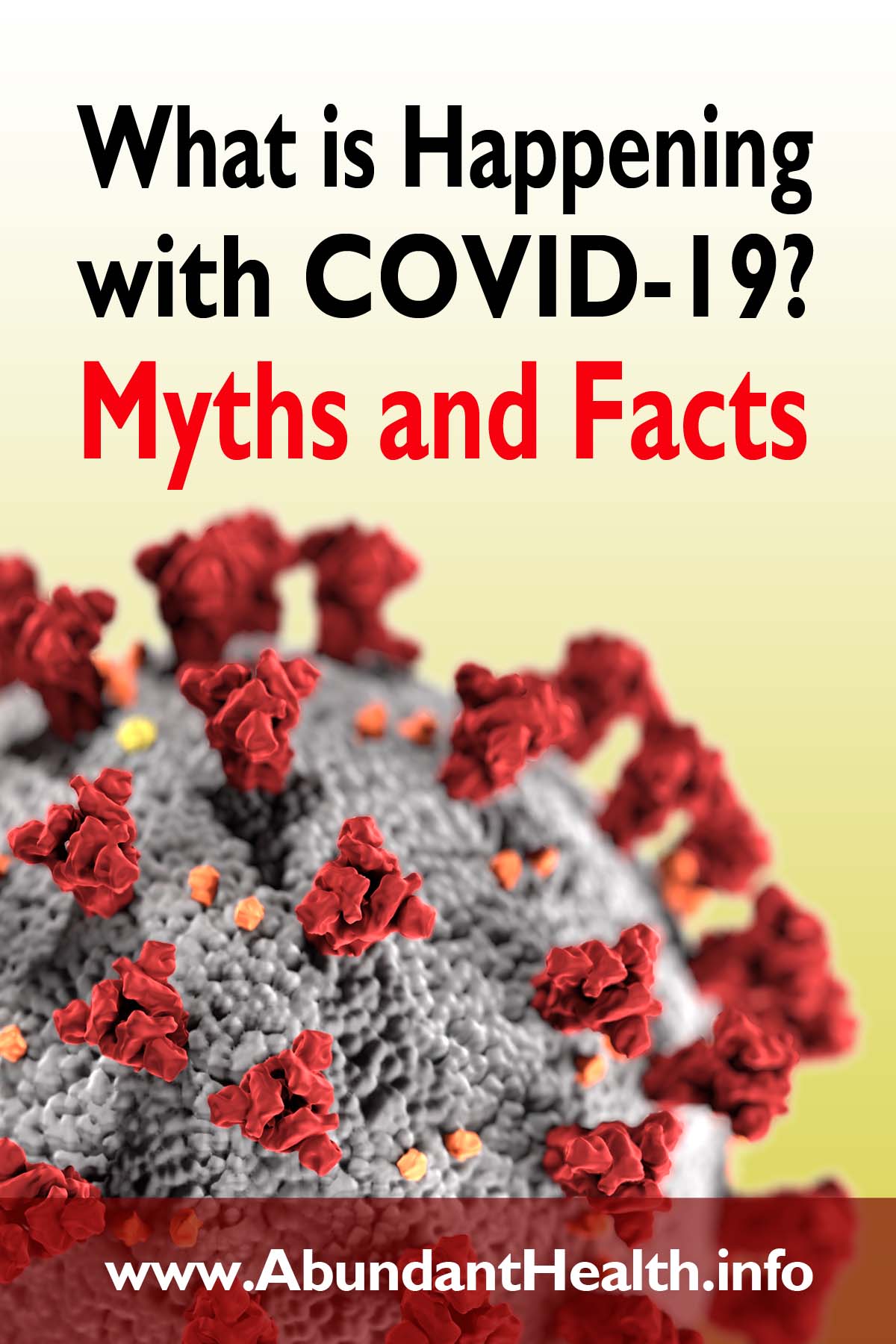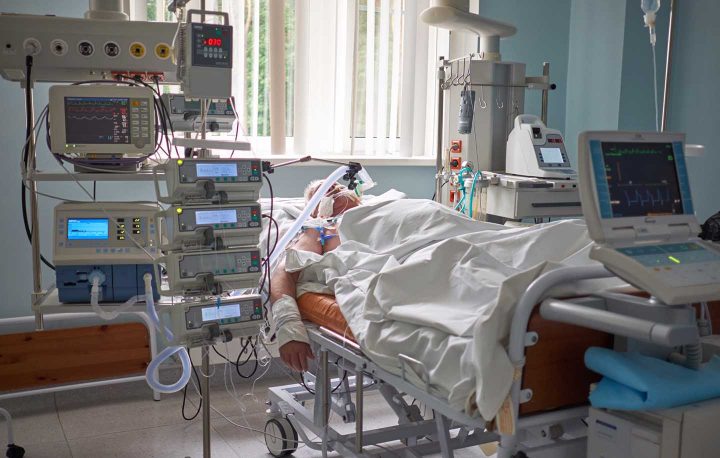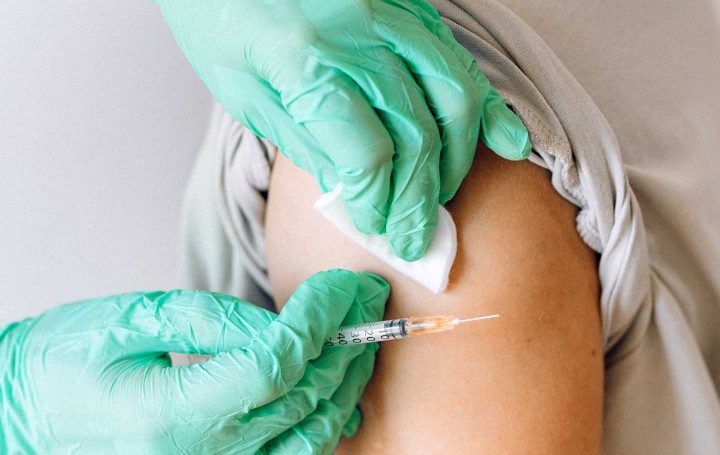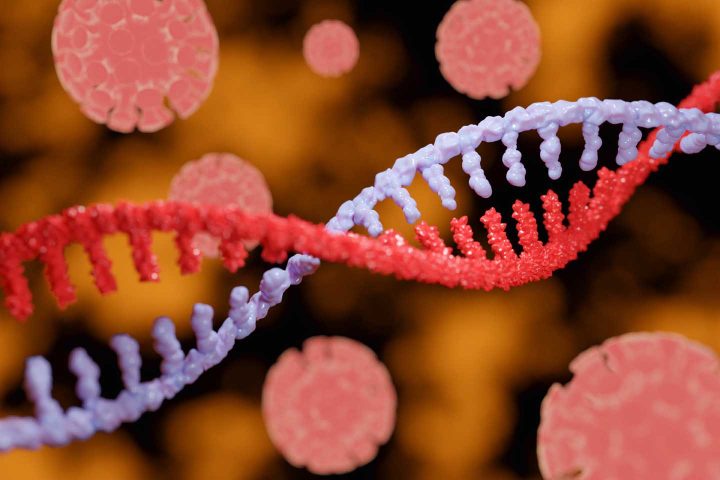The pandemic has affected the life of all of us in very dramatic ways. While dealing with that crisis, we have seen much of conflicting advice, changes in polices, questionable statements, and a counterreaction in the population leading to a widespread distrust and all kinds of conspiracy theories. What are the facts? What are the myths? How can we know?

Although it will be difficult to get a final answer to all the questions raised, we want to give a critical look at the evidences and try to discern a little bit on what might be going on behind the scenes.
Is the pandemic already over?
Since mask mandates were lifted for the most part, the impression may arise that the pandemic is coming to an end. Although some countries have seen a significant reduction of infections and deaths, the pandemic is far from being over. On a worldwide scale we are still seeing about 850,000 new infections and 1,500 deaths registered daily. Furthermore, reduced testing is kind of skewing our statistics of real cases. And even in the US, there are still about 100,000 registered cases every day, which is close to the average we have seen during the entire year of 2021. Daily deaths have though declined quite a bit.1)Statistics: Worldometers
USA: https://www.worldometers.info/coronavirus/country/us/
Worldwide: https://www.worldometers.info/coronavirus/
How is the Pandemic going to end?
This is a question that has been on everyone’s mind since the COVID-19 pandemic started. The good news is that it seems to be slowly ending. The bad news is that we don’t really know how it will end. There are several possible scenarios for how the pandemic will end.
At the moment, new variants tended to be more infectious, but less dangerous. If a large number of the population gets infected, it is probable that a large enough number reaches some kind of immunity, the number of new infections decreases and we reach endemic levels. In this scenario, the number of new infections decreases until it reaches a point where there are just enough new cases to sustain the disease. It’s possible that this could happen, but it’s also possible that a new wave will appear after an unexpected new mutation of the virus.
What is complicating the situation is, that constant mutations and dwindling antibodies make it quite unlikely that herd immunity will stop the spread of the virus. We probably have to coexist with this virus for a while, but most likely it is going to be less of a problem as time goes on.
What are the treatments for COVID-19?
A WHO study done pretty early in the pandemic was testing a few promising treatment options in hospital settings, including hydroxychloroquine. Patient in intensive care did not get any improvement from any drug applied, including Remdesvir, an antiviral drug widely applied during the pandemic. This created a widespread belief that hydroxychloroquine is not efficient for COVID-19 treatment. Interestingly Remdesvir was continued to be applied, even showing its inefficiency in intensive care setting.2)WHO Solidarity Trial

In early treatment, the situation is completely different. For Ivermectin, several independent meta-analyses showed benefits for prevention and treatment alike.3)Hill A et.al. Meta-analysis of randomized trials of ivermectin to treat SARS-CoV-2 infection. DOI:10.21203/rs.3.rs-148845/v1
Ivermectin is effective for COVID-19: real-time meta analysis of 49 studies. https://ivmmeta.com/
Lawrie T. Ivermectin reduces the risk of death from COVID-19 – A rapid review and meta-analysis in support of the recommendation of the Front Line COVID-19 Critical Care Alliance. https://www.e-bmc.co.uk/ But still, Ivermectin continues to be the most praised and most criticized drug of the pandemic and there is still lots of controversy how efficient it really is. Hydroxychloroquine had a similar fate. Even though I am not aware of any solid meta-analysis, some studies showed some slight benefits of its use. It is known that it helps the transport of zinc into the cell, which is essential for immune function, but no study was attempted to test hydroxychoroquine in combination with zinc. It seems that political motives are having a strong influence on science. One motive to downplay those treatment option was probably, that an emergency authorization of vaccines and drugs would not have been possible, if effective treatment options were available.
Going away from drugs, we have studies showing efficiency of Propolis even in hospital settings.4)Duarte Silveira M A et. al. Efficacy of propolis as an adjunct treatment for hospitalized COVID-19 patients: a randomized, controlled clinical trial. Doi https://doi.org/10.1101/2021.01.08.20248932 We know that Vitamin D is highly effective in preventing and treating a COVID-19 infection, and many other supplements and herbs could be just as effective, even no studies are available to prove this. We have an article on COVID-19 treatment going more into details on many of those points.
Are vaccines really protecting against COVID-19?
Well, that is a tricky question, involving many different parameters. First trials of the Pfizer vaccine showed an efficacy of 90% to protect from infections. However, a study from Israel suggests that protection for infection is reduced to 75% after 3 months and it dwindled to 16% after 6 months.5)Jeffay N. Israeli, UK data offer mixed signals on vaccine’s potency against Delta strain. The Times of Israel, June 22, 2022.
How do we explain this difference? We know that antibodies against COVID-19 are dwindling with time. That means, a vaccine will prevent you fairly well from infection in the first 3 months, but after 6 months, the protection against catching the virus is minimal. However, as antibodies are dwindling, memory B Cells are still keeping a memory of the virus, and can quickly produce antibodies during a subsequent infection. For this reason, protection against hospitalization is still around 80% to 90% and will probably stay so for years to come, until the virus mutates too much, turning current vaccines inefficient.6) Jeffay N. Israeli, UK data offer mixed signals on vaccine’s potency against Delta strain. The Times of Israel, June 22, 2022
Craig E. Pfizer’s Covid vaccine efficacy against infection plunges to just 20% after six months – but protection against severe illness barely dips, study concludes. Daily Mail, October 6, 2020
Do I need a booster shot to be protected?
We basically answered the question by looking on how immunity works. Even if you get a booster shot every 6 months, for half of the time you are still pretty much unprotected against catching the virus. However, the intensity of the infection will be less because of memory B cells kicking in. That will be true with or without a booster shot.
Some studies suggest that booster shots are increasing the protection against variants like Omicron. Looking closer at the data you will see that a booster shot with the Pfizer vaccine gives only 2% improvement in immunity compared to somebody who got the 2 dose vaccine recently. Boosting a Pfizer vaccine with a Moderna shot gave an improvement of 8%. For a completed 2 dose Moderna vaccine, protection for Omicrom was at 74.1% the first 2 weeks after completing the 2 dose regime. After the booster shot it was only 66.3% 2 weeks after the booster. In practical terms, the booster shot can just refresh your antibodies, which are again dwindling over time. Besides that, it does not really provide better protection for the Omicron variant.7)Andrews N et. Al. Covid-19 Vaccine Effectiveness against the Omicron (B.1.1.529) Variant. N Engl J Med 2022; 386:1532-1546 DOI: 10.1056/NEJMoa2119451 Protection against severe disease should be valid again without any booster shot. In Germany, the vaccination commission does not recommend a second booster shot, because it is not going to improve your long term protection.8)„Impfung bietet keinen längerfristigen Schutz vor Infektion“, betont Stiko-Chef welt.de, 24.10.2022

If I was infected from COVID-19, do I still need to be vaccinated?
In some countries, being infected is considered to have equal rights as getting the vaccine, for the first 3 to 12 months after the infection. Similar to the vaccine, antibodies will diminish over this time, but memory B cells will give a long-lasting immunity, protecting against severe disease outcome. The immunity aquired by an infection is therefore very much comparable to a vaccine.9)Turner, J.S., Kim, W., Kalaidina, E. et al. SARS-CoV-2 infection induces long-lived bone marrow plasma cells in humans. Nature 595, 421–425 (2021). https://doi.org/10.1038/s41586-021-03647-4
Rodda LB, et.al. Functional SARS-CoV-2-specific immune memory persists after mild COVID-19. Res Sq [Preprint]. 2020 Aug 13:rs.3.rs-57112. doi: 10.21203/rs.3.rs-57112/v1.
Some studies suggest that an infected person can increase the immunity still more by getting the vaccine, concluding that a combination of acquired immunity from the disease and vaccination will give the best form of protection. Nevertheless, the infection by itself is already giving the same immunity then the vaccine by itself, some studies showing even stronger protection than the vaccine. Having been infected will make a vaccination unnecessary. A recommendation to get vaccinated after being infected is based more on politics then on scientific evidence.10)Dra. Sheena Meredith. Covid-19: Por que estamos ignorando a imunidade adquirida com a infecção? Medscape, July 14, 2022
What are the risks of COVID-19 vaccines?
Some vaccines like CoronaVac or Covaxin are using the inactivated virus to create an immune response. The technology involved is not much different than any other vaccine we used during the last few decades. This kind of vaccines should be fairly safe in relation to side effects. CoronaVac was though criticized quite a bit because of limited efficacy to prevent against disease and hospitalization.
At the other hand, mRNA vaccines like Pfizer and Moderna and viral vector vaccines like the AstraZeneca and Johnson&Johnson vaccine are new technologies that include gene-manipulated substances that are instructing body cells to replicate the spike protein. These are technologies that never have been deployed in large scale to the public, since technological problems were still manifold. During the need of the pandemic, approval of this new technologies has been fast-tracked in order to help to resolve the crisis. There is much that is still unknown about long-term side effects of those technologies, and anybody who is concerned about putting GMO foods into their stomach, will be probably concerned about injecting a gene-manipulated substance into the bloodstream as well.

There was much discussion whether those technologies will manipulate the DNA of the human body. For the mRNA vaccines this is quite unlikely, since they are replicating the spike protein through channeling a RNA structure into some of your body cells, and instructing them to replicate the virus. In this technology the substance is not entering the DNA at all. The viral vector vaccines are different, since they are really entering the DNA and instructing that way the cell to produce the spike protein, very similar than many viruses will do. This would be potentially the riskiest among those vaccine technologies involved.
While those questions of the unknown may be a concern for many, let’s focus on something we know to be a problem, and that are the spike proteins. Studies have shown that this spike protein is able to damage cells independently of the virus itself.11)Lei Y et.al. SARS-CoV-2 Spike Protein Impairs Endothelial Function via Downregulation of ACE 2. Circulation Research. 2021;128:1323–1326 https://doi.org/10.1161/CIRCRESAHA.121.318902
Another study showed that spike proteins are able to influence cell signaling and could lead to PAH, a serious lung disease, blood clotting, coronary artery disease, hypertension and stroke.12)Suzuki Y et. al. SARS-CoV-2 Spike Protein Elicits Cell Signaling in Human Host Cells: Implications for Possible Consequences of COVID-19 Vaccines. Vaccines (Basel). 2021 Jan; 9(1): 36. doi: 10.3390/vaccines9010036 The spike protein can also damage the blood brain barrier and cause unpredictable brain damage, that shows up in several symptoms, for the disease and the vaccine alike.13)Buzhdygan TP et.al. The SARS-CoV-2 spike protein alters barrier function in 2D static and 3D microfluidic in-vitro models of the human blood-brain barrier. Neurobiol Dis. 2020 Dec;146:105131. DOI: 10.1016/j.nbd.2020.105131
With an inactivated virus, like used in CoronaVac, the exposure to the spike protein will be quite limited. The newer vaccine technologies instruct though the body cells to produce spike proteins, and literally inundate the entire body with this damage causing substance.
It is important to note that the spike protein of vaccines was modified in order to cleave to cells and not enter into them, so not all findings of the studies may apply equally for the spike protein of the vaccines. It would be interesting to make some studies with both spike proteins to have a clear comparation between the two, but as far as I know this was not done so far.
Now what do we have on real world statistical data? There is a reporting system, that collects potential side effects of any vaccine applied or produced in the US, called VAERS (Vaccine Adverse Effect Reporting System). In normal years there are reported around 150 deaths for all 70 registered vaccines combined. Now for the COVID-19 vaccines we have already close to 16,000 deaths reported in the US alone, during the 1 ½ years that the vaccines were applied.14)Original VAERS dataset: https://wonder.cdc.gov/controller/saved/D8/D173F192 Data from other countries who have a reporting system in place is not much different.
Of course, we know that a reported incident in the system does not prove that it was really caused by the vaccine. There may be some deaths reported, that were randomly happening after the vaccination, but were not directly caused by the event. At the other hand, the reporting system is completely voluntary, and only a small percentage of all incidents are getting really reported. Some estimates will go that the real number would be about 5 times higher. Even though it is very hard to come up with any exact numbers, we can deduce that the COVID-19 vaccines are not quite as safe as your common flu shot.
In order to be fair, we need to put this numbers into perspective. Even if we estimate somewhere around 100,000 deaths by the vaccine, we need to contrast that to about one million deaths by the virus in the US territory. Going with the assumption that the vaccine helped to control the spread of the virus, the vaccine still helped to save lives.
At the other hand, the statistics of side effects and deaths are high enough to be of a serious concern, and should cause a constructive discussion in scientific circles. This discussion though is not happening. In the media, any mention of serious vaccine side effects is actively suppressed. On Facebook, groups reporting vaccine side effects are getting deleted. The government did a simplified reporting system called V-Safe, where anybody could report side effects of the COVID-19 vaccines from their cell phone, but the data is not made publicly available. Censorship prevails at every corner. And it seems that even scientific studies are tweaked in order to support the politically correct narrative. If there is any discussion at all about vaccine safety, it is most likely to be emotionally loaded, with everybody defending their position and no constructive dialogue involved.
Robert Malone is a scientist that was involved in the invention of the mRNA technology. He made on a LinkedIn post the following statement about the current COVID-19 vaccines:
Once again I feel it necessary to make a clear and unambiguous statement. The data strongly indicate that the experimental genetic vaccines, including the mRNA and recombinant adenoviral vaccines, have saved lives. Many lives.
But it is also increasingly clear that there are some risks associated with these vaccines. Various governments have attempted to deny that this is the case. But they are wrong. Vaccination-associated coagulation is a risk. Cardiotoxicity is a risk. Those are proven, and discussed in official USG communications, as well as communications from a variety of other governments.
Based on what I have seen, I believe that other toxicity risks will become more apparent. These include menstrual irregularities, development of thrombocytopenia, cerebrovascular effects, and reactivation of latent viruses such as clinical shingles.
But we do not know how prevalent these are, and the spectrum of severity is unknown and possibly unknowable because the V-Safe database is not being shared outside of CDC, the VAERS systems is deeply flawed, and we just do not have the comprehensive safety data necessary to accurately evaluate risk/benefit for the various cohorts – elderly, healthy normal adults, immunocompromised, pregnancy, adolescents, children, and infants. Particularly the long term safety data necessary to evaluate risks such as autoimmune complications that may manifest months or years post-vaccination. That is just a sciencefact.
Robert Malone
This is just one example of many thinkers in scientific circles who call for an unbiased scientific discussion of vaccine safety, especially in some more vulnerable subgroups.
Are COVID-19 vaccines safe for pregnant women?
There are several studies who tried to evaluate exactly this question. While there is some adequate data for vaccine safety in the second and third trimester, it gets more complicated in the first trimester of pregnancy, which is exactly the most critical phase.

One study assessing the safety of the vaccine during pregnancy concluded that the abortion rate of women vaccinated in the first trimester would be 12.6% and the published rate for the normal population 10-26%. Looking at this data, they concluded the vaccine was totally safe, even in the first trimester of pregnancy.15)The results are in table 4 of this study:
Shimabukuro TT, Kim SY, Myers TR, et al. Preliminary Findings of mRNA Covid-19 Vaccine Safety in Pregnant Persons. N Engl J Med. 2021;384(24):2273-2282. doi:10.1056/NEJMoa2104983
Find the data of the uncorrected chart in this note:
https://www.nejm.org/doi/full/10.1056/NEJMx210016
A reader of the journal found some faults with that and commented the following:
In table 4, the authors report a rate of spontaneous abortions <20 weeks of 12.5% (104 abortions/827 completed pregnancies). However, this rate should be based on the number of women who were at risk of a spontaneous abortion due to vaccine receipt and should exclude the 700 women who were vaccinated in their third-trimester (104/127 = 82%). We acknowledge this rate will likely decrease as the pregnancies of women who were vaccinated <20 weeks complete, but believe the rate will be higher than 12.5%. However, given the importance of these findings we feel it important to report these rates accurately. Additionally, the authors indicate that the rate of spontaneous abortions in the published literature is between 10% and 26%. However, the upper cited rate includes clinically-unrecognized pregnancies, which does not reflect the clinically-recognized pregnancies of this cohort and should be removed.
Let us analyze this comment a bit closer. The study came up with a 12.5% risk of abortion by dividing the 104 abortions in the first trimester with 827 completed pregnancies. Just the completed pregnancies included women that were vaccinated in the second and third trimester. This is obviously not statistically correct. Like the reader pointed out, only 127 women that were vaccinated in the first trimester completed the pregnancy, since the rest was still pregnant and their outcome was still unknown. The reader concluded that the real rate would be somewhat higher than 12.5%, but definitely below the 82% she was mentioning in this note.
Now the manipulation of the reference values is critical. The study mentioned a first trimester abortion rate of 10% to 26% in the normal population. Just the 26% rate is including clinically unrecognized pregnancies, who aborted without the pregnant women ever realizing that they were pregnant. Obviously, the vaccinated women in the study knew that they were pregnant in order to be included into the study. The correct rate to be applied would be therefore 10%, thus showing an increased risk of abortion even with the statistically wrong calculation of 12.5% risk. That smells very much like deliberate manipulation! This note was sent to the journal but was not getting published.
The story continues. The anti-vaccination defender Steve Kirsch got news about this letter and published in his article that the study has proven an 82% abortion rate within the first trimester.16)Steve Kirsch. Should you get vaccinated? Trialsitenews, December 15, 2021 This is obviously not what the reader said and equally wrong. It is sad to see that distortion of the facts are applied by both parties alike. I wonder when we can come to the point of defending the truth instead of bending it for political reasons, in order to make our viewpoint look better.
The critique had though some effect. Finally, the paper published a correction of the study and removed any definite statistics about first trimester pregnancies. It took them though from June till September to publish this correction, and probably only to avoid the criticism received by the opposition. Interestingly, until today I am not aware of any study that really settles vaccine safety during the first trimester of pregnancy.
Shall I get vaccinated after all?
This is a very individual question that nobody can answer for somebody else. We have seen that there are risks at both sides. You may be inclined to recommend a vaccine to a person in the at-risk group, like the elderly, diabetics, obese, immunocompromised etc. At the other hand, this is exactly the same group that will be more vulnerable for vaccine side effects. I would be very hesitant to recommend a vaccine to a 98-year-old grandma, being diabetic and so weak that she spends most of time in her bed. She may not be able to resist the side effects of the vaccination, and it may be safer to simply protect her from exposure to the virus.
Lets look at another criteria to help in this decision, which is probability of exposure. If you a salesperson that sees so many persons every day, and you do not take good care of your lifestyle in order to strengthen your immunity, then vaccination could be of interest for you. If you are living on a farm, way out in the country, you visit town only once a week and you take good care of your immunity, then you may get by very well without vaccination.

We already said that if you were infected from COVID-19 you already created sufficient immunity and you can safely go without vaccine. As a fact, getting vaccinated within 1-2 month after being infected, can even increase your risk for vaccine side effects. If you want to get vaccinated, you should definitely wait if you got infected recently.
Vaccination of mostly healthy children is something that probably will bring more harm than benefits as well. Some do argue, that children should be vaccinated in order to protect adults, but we have shown already, that protection from infection is not very effective, even with booster shots every 6 months. Nobody protects somebody else by getting vaccinated. Hospitalization and deaths from the virus are quite rare amongst healthy children, and there is no need to expose them to the vaccine.
Booster shots are another thing that is probably causing more harm than benefit. Even without a booster shot, you have adequate protection against hospitalization and death, and every booster is going to expose you anew to a load of spike protein, causing potential damage to your body.
At the end of the day, you should be well informed about the pros and cons and make an informed decision for yourself. Those who are vaccinated do not need to be afraid of the unvaccinated, because the vaccine is protecting yourself, and not the other person. We have clearly stated that a vaccine does not adequately limit the spread of the virus. And whoever is refusing vaccination, should be sure about his decision and not criticizing those who think differently. I hope the day of throwing stones can come to an end and we can simply live out the convictions we have about the subject. And hopefully, one day we can start a constructive discussion of risks and benefits of the vaccine.
What else can I do to be protected?
As a preventive measure, all efforts should be made to strengthen your immune system. A study conducted in Madrid, found that people who did at least 2 times per week a 30-minute exercise session had an 8 times higher COVID-19 survival rate compared to the inactive group.17)Salgado-Aranda R et.al. Influence of Baseline Physical Activity as a Modifying Factor on COVID-19 Mortality: A Single-Center, Retrospective Study. Infect Dis Ther (2021). https://doi.org/10.1007/s40121-021-00418-6

Nutrition has an equal importance. A study of healthcare workers in 6 countries found, that those who were on a plant-based diet had a 3.7 times better protection against moderate to severe COVID-19 infections. Interestingly, those who were on a low carb diet had a 1.5 times higher risk.18) Kim H, et. al. Plant-based diets, pescatarian diets and COVID-19 severity: a population-based case-control study in six countries. BMJ Nutr Prev Health. 2021 Jun 7;4(1):257-266. doi: 10.1136/bmjnph-2021-000272.
Even though there are no studies around in relation to COVID-19, there are benefits of good sleep, proper hydration and other healthy habits as well. We know quite a bit of the importance of proper Vitamin D levels for immunity. A study showed that vitamin D deficient individuals had twice as much a risk of hospitalization for COVID-19 compared to normal levels.19) E Merzon et.al. Low plasma 25(OH) vitamin D level is associated with increased risk of COVID-19 infection: an Israeli population-based study. FEBS J. 2020 Sep;287(17):3693-3702. DOI: 10.1111/febs.15495
If you just practice those 3 lifestyle factors, your immunity is already better than any vaccine can offer for you. And we did not talk yet about reduction of sugar, proper vitamin status and several other things we are able to do as a preventive measure.
I think it is time to think seriously about our lifestyle. If we do the right thing, we are not only so much better protected against COVID-19, but as well against heart disease, cancer, diabetes and other lifestyle diseases that cost many more lives than COVID-19 at this point in time. If you want to learn how to strengthen your immunity with a sensible lifestyle, follow the Coronavirus Immunity Challenge on our website. So stop arguing, and decide to do the right thing!
We have a special opportunity just for you. If you want to receive practical and up to date advice on how to implement an immunity-boosting lifestyle, simply join the Coronavirus Immunity Challenge and prepare yourself to face the pandemic with a bullet-proof immune system.
Coronavirus Immunity Challenge

Martin Neumann was trained for Lifestyle Interventions in 1998 at Wildwood Lifestyle Center & Hospital. Since then he has lectured in different parts of the world about a healthy lifestyle and natural remedies. He is the founder of the Abundant Health website.
References
| ↑1 | Statistics: Worldometers USA: https://www.worldometers.info/coronavirus/country/us/ Worldwide: https://www.worldometers.info/coronavirus/ |
|---|---|
| ↑2 | WHO Solidarity Trial |
| ↑3 | Hill A et.al. Meta-analysis of randomized trials of ivermectin to treat SARS-CoV-2 infection. DOI:10.21203/rs.3.rs-148845/v1 Ivermectin is effective for COVID-19: real-time meta analysis of 49 studies. https://ivmmeta.com/ Lawrie T. Ivermectin reduces the risk of death from COVID-19 – A rapid review and meta-analysis in support of the recommendation of the Front Line COVID-19 Critical Care Alliance. https://www.e-bmc.co.uk/ |
| ↑4 | Duarte Silveira M A et. al. Efficacy of propolis as an adjunct treatment for hospitalized COVID-19 patients: a randomized, controlled clinical trial. Doi https://doi.org/10.1101/2021.01.08.20248932 |
| ↑5 | Jeffay N. Israeli, UK data offer mixed signals on vaccine’s potency against Delta strain. The Times of Israel, June 22, 2022 |
| ↑6 | Jeffay N. Israeli, UK data offer mixed signals on vaccine’s potency against Delta strain. The Times of Israel, June 22, 2022 Craig E. Pfizer’s Covid vaccine efficacy against infection plunges to just 20% after six months – but protection against severe illness barely dips, study concludes. Daily Mail, October 6, 2020 |
| ↑7 | Andrews N et. Al. Covid-19 Vaccine Effectiveness against the Omicron (B.1.1.529) Variant. N Engl J Med 2022; 386:1532-1546 DOI: 10.1056/NEJMoa2119451 |
| ↑8 | „Impfung bietet keinen längerfristigen Schutz vor Infektion“, betont Stiko-Chef welt.de, 24.10.2022 |
| ↑9 | Turner, J.S., Kim, W., Kalaidina, E. et al. SARS-CoV-2 infection induces long-lived bone marrow plasma cells in humans. Nature 595, 421–425 (2021). https://doi.org/10.1038/s41586-021-03647-4 Rodda LB, et.al. Functional SARS-CoV-2-specific immune memory persists after mild COVID-19. Res Sq [Preprint]. 2020 Aug 13:rs.3.rs-57112. doi: 10.21203/rs.3.rs-57112/v1. |
| ↑10 | Dra. Sheena Meredith. Covid-19: Por que estamos ignorando a imunidade adquirida com a infecção? Medscape, July 14, 2022 |
| ↑11 | Lei Y et.al. SARS-CoV-2 Spike Protein Impairs Endothelial Function via Downregulation of ACE 2. Circulation Research. 2021;128:1323–1326 https://doi.org/10.1161/CIRCRESAHA.121.318902 |
| ↑12 | Suzuki Y et. al. SARS-CoV-2 Spike Protein Elicits Cell Signaling in Human Host Cells: Implications for Possible Consequences of COVID-19 Vaccines. Vaccines (Basel). 2021 Jan; 9(1): 36. doi: 10.3390/vaccines9010036 |
| ↑13 | Buzhdygan TP et.al. The SARS-CoV-2 spike protein alters barrier function in 2D static and 3D microfluidic in-vitro models of the human blood-brain barrier. Neurobiol Dis. 2020 Dec;146:105131. DOI: 10.1016/j.nbd.2020.105131 |
| ↑14 | Original VAERS dataset: https://wonder.cdc.gov/controller/saved/D8/D173F192 |
| ↑15 | The results are in table 4 of this study: Shimabukuro TT, Kim SY, Myers TR, et al. Preliminary Findings of mRNA Covid-19 Vaccine Safety in Pregnant Persons. N Engl J Med. 2021;384(24):2273-2282. doi:10.1056/NEJMoa2104983 Find the data of the uncorrected chart in this note: https://www.nejm.org/doi/full/10.1056/NEJMx210016 |
| ↑16 | Steve Kirsch. Should you get vaccinated? Trialsitenews, December 15, 2021 |
| ↑17 | Salgado-Aranda R et.al. Influence of Baseline Physical Activity as a Modifying Factor on COVID-19 Mortality: A Single-Center, Retrospective Study. Infect Dis Ther (2021). https://doi.org/10.1007/s40121-021-00418-6 |
| ↑18 | Kim H, et. al. Plant-based diets, pescatarian diets and COVID-19 severity: a population-based case-control study in six countries. BMJ Nutr Prev Health. 2021 Jun 7;4(1):257-266. doi: 10.1136/bmjnph-2021-000272. |
| ↑19 | E Merzon et.al. Low plasma 25(OH) vitamin D level is associated with increased risk of COVID-19 infection: an Israeli population-based study. FEBS J. 2020 Sep;287(17):3693-3702. DOI: 10.1111/febs.15495 |
Leave a Reply